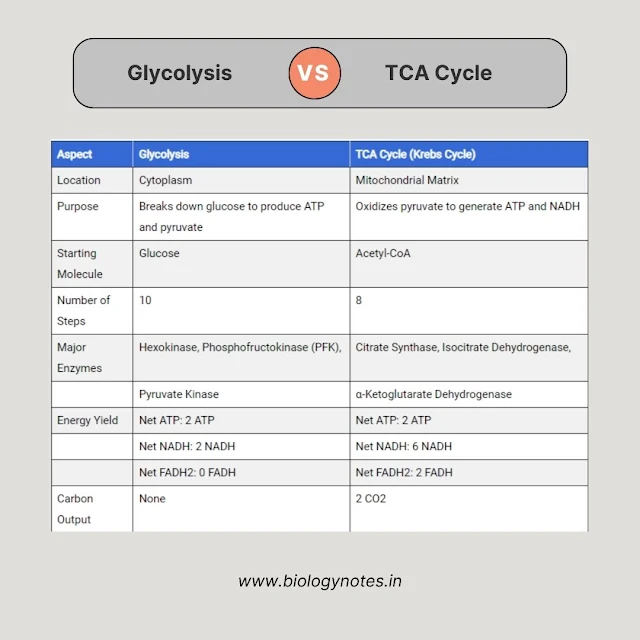Difference Between Glycolysis and TCA Cycle: Hello students as we know Inside our cells, there are two important biochemical processes called Glycolysis and the Krebs Cycle, which help make energy. Glycolysis occurs in the cytoplasm and it breaks down a big sugar called glucose into smaller pieces called pyruvate, making a little bit of energy called ATP and a helper molecule called NADH.
The Krebs Cycle, also known as the citric acid cycle, works in another part of the cell called the mitochondria. It takes those pyruvate pieces from Glycolysis and breaks them down even more, making more ATP, NADH, and another helper called FADH2.
One key difference between Glycolysis and TCA Cycle is where they work: Glycolysis occurs in the cytoplasm, while the Krebs Cycle occurs in mitochondria. Also, Glycolysis is like a straight road, but the Krebs Cycle goes in circles.
Both biochemical processes are super important because they help the cell make ATP, which is like the cell's fuel for everything it needs to do.
Read: Difference between glycolysis and gluconeogenesis
Difference between Glycolysis and TCA Cycle:
| Glycolysis | Kreb Cycle |
|---|---|
| Glycolysis is a metabolic process in which glucose (C6H12O16) is converted into Pyruvic Acid (CH3COCOOH). | The TCA cycle is a series of chemical reactions used by all organisms to release and store energy through the oxidation of Acetyl CoA derived from Carbohydrates, fats, and Proteins |
| Glycolysis is also known as the EMP pathway. | Kreb cycle is also known as TCA cycle (Tri carboxylic acid cycle) or Citric Acid cycle. |
| Glycolysis was discovered by Embden, Meyerhof and Parnas in 1940. | Citric Acid cycle is discovered by Hans Kreb's |
| Glycolysis occurs in the Cytoplasm | Kreb cycle occurs in the Matrix of Mitochondria |
| Glycolysis is the first step of aerobic respiration which produces two molecules of pyruvate (3 carbon-containing compounds) after the partial breakdown of glucose. | Kreb cycle is the second step of aerobic respiration in which pyruvic acid is completely oxidized into organic substances and forms Co2 |
| Glycolysis occurs in All living organisms | The TCA cycle occurs only in Aerobic Organisms that require Oxygen for their growth and development. |
| Oxygen is not required in the process of glycolysis. | Oxygen is a must for the Kreb cycle |
| No Co2 Evolved | Co2 evolved |
| Glycolysis takes place in Aerobic and anaerobic respiration | The tricarboxylic acid cycle takes place in Aerobic respiration. |
| Glycolysis occurs in a linear sequence. | It occurs in a cyclic manner. |
| In glycolysis, glucose acts as a substrate. | In Creb Cycle Acetyl CoA Act as Substrate. |
| It produces Pyruvic acid, NADH, and ATP. | It produces oxalic acid, FADH2, NADH2, ATP, and CO2. |
| A total of Four ATP molecules are produced in glycolysis by One glucose molecule. | One ATP or GTP molecules are produced by substrate-level Phosphorylation at each turn of the TCA cycle. |
What is glycolysis?
- Glycolysis is the universal pathway of sugar catabolism in all living organisms.
- This process is carried out in the cytoplasm and does not require oxygen, and each reaction step is basically catalyzed by a specific enzyme.
- Glucose is degraded to generate ATP through glycolysis, which provides some energy for life activities, especially for anaerobic organisms, which is the main way to obtain energy.
- This reaction process is generally carried out under anaerobic conditions, also known as anaerobic decomposition.
What is TCA Cycle?
- The citric acid cycle is also known as the tricarboxylic acid cycle (TCA) or Krebs cycle.
- It occurs in the mitochondrial matrix.
- It is a cyclic system for the enzymatic reaction of acetyl-CoA oxidation to CO2, the
- The first step in the cycle is the condensation of acetyl-CoA with oxaloacetate to form citric acid.
- In the tricarboxylic acid cycle, the reactant glucose or fatty acid will become acetyl-CoA (Acetyl-CoA).
What are the difference between Glycolysis and TCA Cycle step by step:
| Aspect | Glycolysis | TCA Cycle (Krebs Cycle) |
|---|---|---|
| Location | Cytoplasm | Mitochondrial Matrix |
| Purpose | Breaks down glucose to produce ATP and pyruvate | Oxidizes pyruvate to generate ATP and NADH |
| Starting Molecule | Glucose | Acetyl-CoA |
| Number of Steps | 10 | 8 |
| Major Enzymes | Hexokinase, Phosphofructokinase (PFK), | Citrate Synthase, Isocitrate Dehydrogenase, |
| Pyruvate Kinase | α-Ketoglutarate Dehydrogenase | |
| Energy Yield | Net ATP: 2 ATP | Net ATP: 2 ATP |
| Net NADH: 2 NADH | Net NADH: 6 NADH | |
| Net FADH2: 0 FADH | Net FADH2: 2 FADH | |
| Carbon Output | None | 2 CO2 |
| Regulation | Regulated by feedback inhibition by ATP, ADP, and AMP | Regulated by allosteric enzymes and substrate availability |
| Rate Limiting Step | Phosphofructokinase (PFK) | Isocitrate Dehydrogenase |
| Key Features | - Anaerobic process | - Aerobic process |
| - Occurs in all cells | - Occurs in mitochondria of eukaryotes | |
| - Generates 2 ATP and 2 NADH | - Generates 2 ATP, 6 NADH, and 2 FADH2 | |
| - Involves both energy investment and payoff phases | - Sequential reactions cycle through compounds | |
| - Primarily produces reduced coenzymes (NADH and FADH2) |
